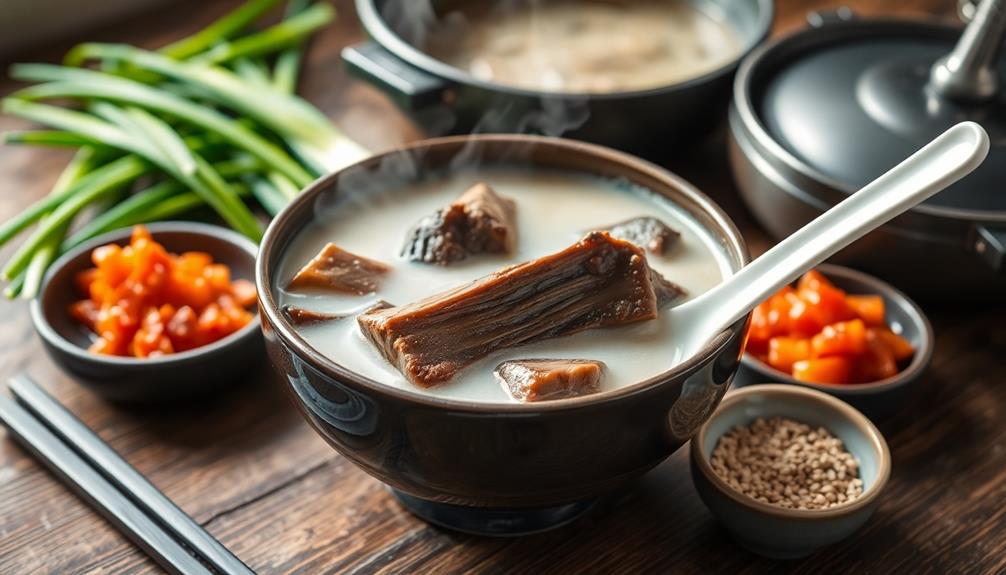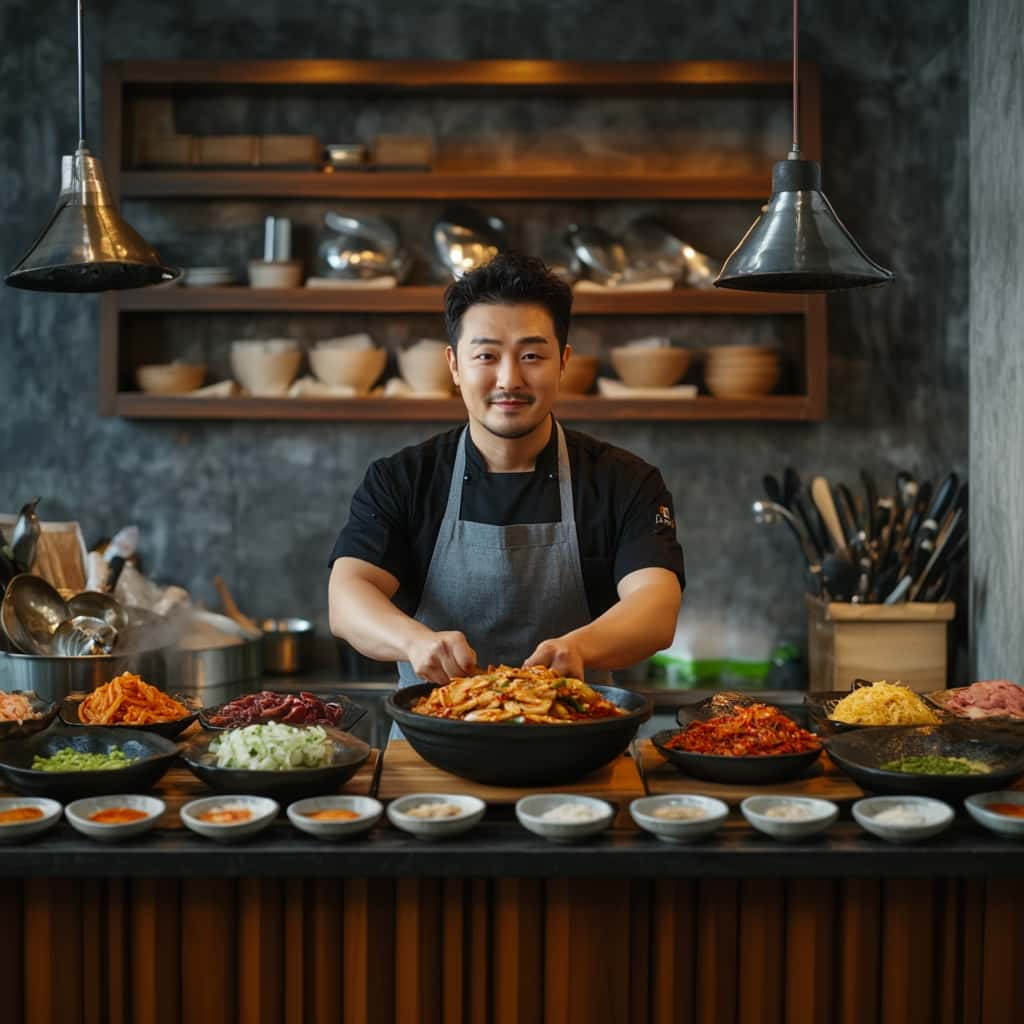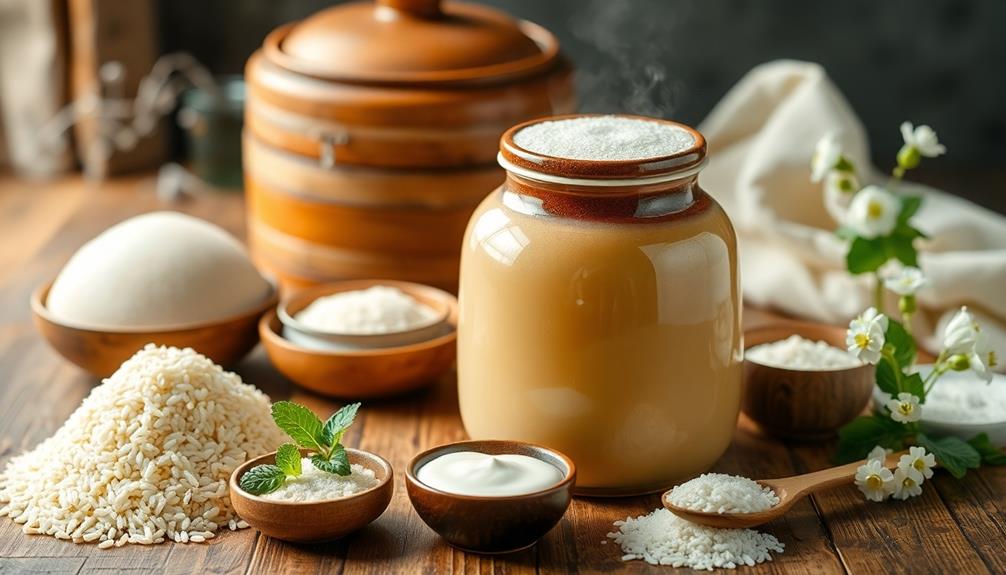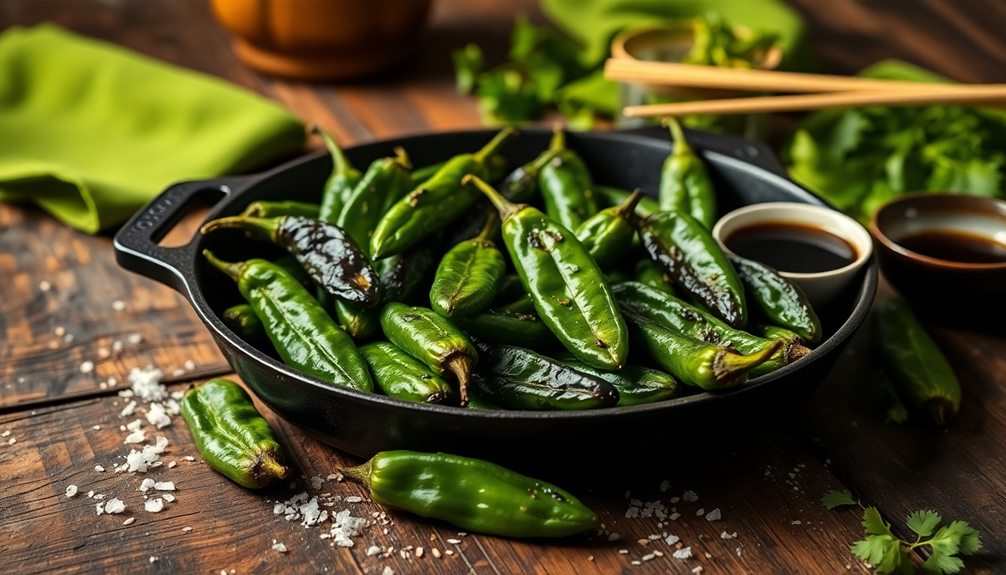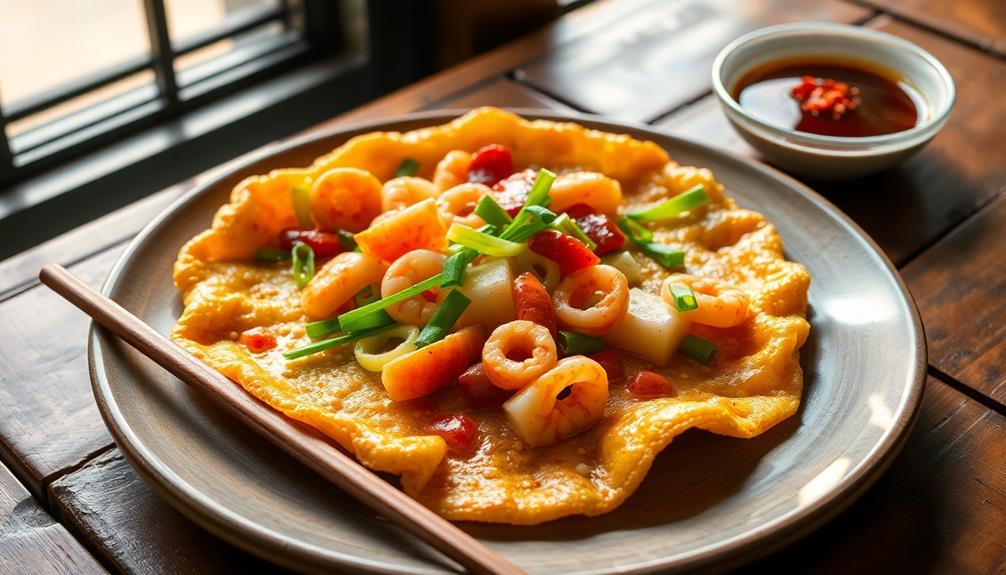Seolleongtang is a delicious and cozy ox bone soup, perfect for warming you up on chilly days! Originating from Korea, this hearty dish features a rich, creamy broth made by simmering ox bones for many hours. You can enjoy it with tender meat, rice, and tasty toppings like green onions and pepper. To make your own, soak the bones, boil them briefly, then simmer with garlic, onions, and water. It's super comforting and even believed to help when you're feeling under the weather. Curious to learn how to make this delightful dish yourself? There's so much more to discover!
Key Takeaways
- Seolleongtang is a traditional Korean ox bone soup known for its rich, creamy broth and tender meat, originating from the Joseon Dynasty.
- The dish requires a long simmering time of 8-10 hours to develop its deep flavors and milky texture, making it comforting year-round.
- It is typically served with steamed rice and customizable toppings like green onions and pepper, enhancing the meal's personalization.
- Soaking the bones and skimming fat during cooking are essential steps for achieving a clear and flavorful broth.
- Seolleongtang symbolizes family gatherings and has cultural significance, often enjoyed as a remedy for fatigue and colds.
History
Seolleongtang, a traditional Korean ox bone soup, has a rich history that dates back to the Joseon Dynasty, when it was commonly served to the royal family. Imagine being a part of that royal court, tasting a soup that's both warm and comforting.
The chefs worked hard to create this delicacy, boiling ox bones for hours, and sometimes even days! This long cooking process helps create the creamy, milky broth that you see today.
As time went on, Seolleongtang spread beyond the royal kitchens and into the homes of ordinary people. It became a beloved dish, especially during cold winters when everyone craved something hearty and nourishing.
People would gather around the table, sharing stories and laughter while enjoying bowls of this delicious soup.
You might find it surprising, but Seolleongtang was also considered a great remedy for many ailments. Folks believed that the soup could help with everything from fatigue to a simple cold.
So, not only was it tasty, but it also had some magical healing powers! Today, you can enjoy Seolleongtang in many Korean restaurants, keeping this yummy tradition alive and well.
Isn't that just fantastic?
Recipe
Seolleongtang, a traditional Korean ox bone soup, is celebrated for its rich, milky broth and tender meat. This comforting dish is often enjoyed during colder months but can be savored any time of the year. The process of making Seolleongtang involves simmering ox bones for an extended period, allowing the flavors to meld together and creating a hearty and nourishing soup. Another popular Korean soup similar to Seolleongtang is the Korean pork spine soup recipe known as Gamjatang. This dish also features a rich and flavorful broth, but with the addition of pork spine and potatoes for a heartier texture. Both of these soups are beloved in Korean cuisine for their comforting and nourishing qualities, making them a staple in many households.
It's typically served with a side of rice and a selection of condiments, such as salt, pepper, and green onions, which enhance the flavor and allow each diner to customize their bowl to their liking.
Preparing Seolleongtang may take some time, but the effort is well worth it for the deep, umami flavor and the satisfying texture of the meat. The key to a successful broth lies in the quality of the bones and the slow cooking process. As the bones simmer, they release collagen and nutrients that contribute to the soup's signature creamy consistency.
Following this recipe will guide you through making your very own Seolleongtang at home, resulting in a delicious and soul-warming meal.
Ingredients:
- 2 kg ox bones (preferably leg bones and neck bones)
- 500 g beef brisket (optional)
- 1 onion, halved
- 2-3 cloves garlic
- 2-3 green onions
- Salt (to taste)
- Black pepper (to taste)
- Steamed rice (for serving)
- Additional green onions, chopped (for garnish)
Cooking Instructions:
Start by soaking the ox bones in cold water for at least 3 hours, changing the water a couple of times to remove impurities. After soaking, place the bones in a large pot and cover them with fresh water, bringing it to a boil.
Once boiling, let it cook for about 10 minutes before draining the bones and discarding the water. This process helps to purify the bones. Next, return the bones to the pot, add the onion, garlic, and enough water to cover the bones completely.
Bring it to a boil again, then reduce the heat to low and let it simmer for 8-10 hours. If using brisket, add it halfway through the cooking time. After simmering, strain the broth to remove the solids, then season with salt and black pepper to taste.
Serve hot with steamed rice and garnished with chopped green onions.
Extra Tips:
For a richer flavor, consider roasting the bones in the oven at 200°C (400°F) for about 30 minutes before adding them to the pot. This will enhance the depth of the broth.
Additionally, a slow cooker can be used for the simmering process, allowing for a more hands-off approach while still achieving that tender, flavorful outcome. Remember to adjust the seasoning before serving, as the saltiness can vary based on personal preference.
Enjoy your homemade Seolleongtang with your favorite condiments!
Cooking Steps
To make a delicious bowl of Seolleongtang, you'll start by soaking the bones overnight, which helps to get rid of any impurities.
Then, you'll simmer them for several hours, filling your kitchen with a warm and comforting aroma.
After skimming the fat from the broth, you can add a pinch of salt to taste and strain it thoroughly, creating a soup that's rich and flavorful—perfect for sharing with family and friends!
Step 1. Soak Bones Overnight
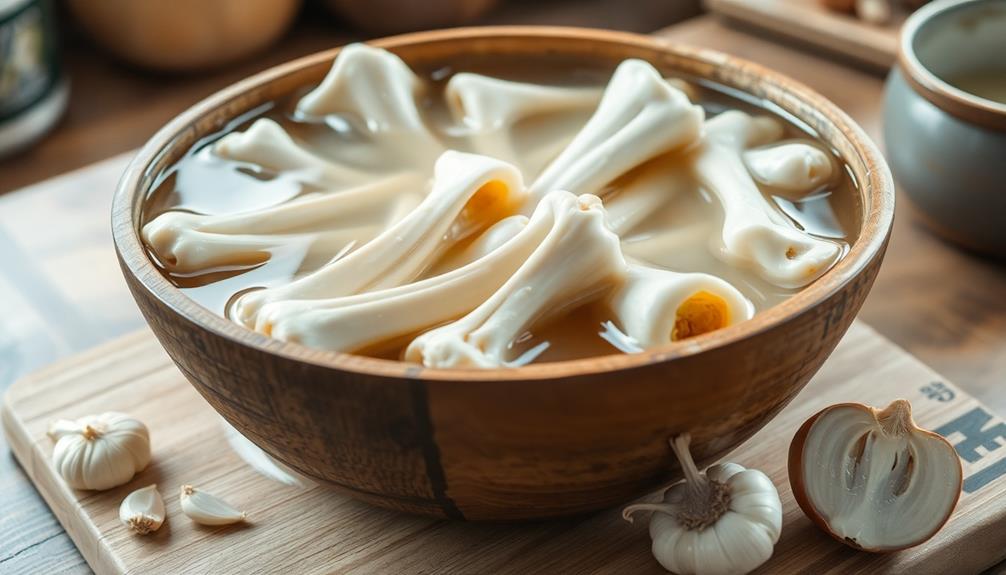
Before you start cooking, soaking the bones overnight is crucial for achieving the rich, creamy broth that defines Seolleongtang. This step helps to draw out impurities, making your soup taste even better. You'll want to grab some good-quality ox bones—marrow bones work great!
First, place the bones in a large bowl or pot. Then, fill it up with cold water, covering the bones completely. This is where the magic happens! Let them soak for at least 8 hours (or overnight), so don't forget to set a reminder. The longer you soak, the more flavor and nutrients you'll get into your broth.
Every few hours, it's a good idea to change the water. This helps remove any gunky stuff that might float to the surface. You can think of it like giving your bones a little spa treatment!
Once the soaking is done, rinse the bones under running water to wash away any remaining impurities.
Now you're all set for the next step! With your bones prepped and ready, you'll create a delicious Seolleongtang that everyone will love. Happy cooking!
Step 2. Simmer for Several Hours

With the bones prepped and ready, it's time to bring everything together by simmering them for several hours. First, place the bones into a large pot and cover them with fresh water. You'll want enough water so the bones are completely submerged, just like they're taking a nice bath!
Now, turn the heat up to high until the water starts to boil. Once it's boiling, reduce the heat to low and let it simmer gently.
As the soup bubbles away, the magic begins! The longer you simmer, the richer and tastier your broth will become. Aim for at least 6 to 8 hours. If you can, let it go even longer. It's like a slow dance of flavors, and you'll be amazed at how the bones release their goodness into the soup.
You might want to check the pot every so often, giving it a little stir and enjoying the delightful aroma wafting through your kitchen.
Just remember, patience is key! While you wait, you can prepare your favorite side dishes or practice your chopstick skills. Soon, you'll have a warm and comforting bowl of seolleongtang to enjoy!
Step 3. Skim Fat From Broth
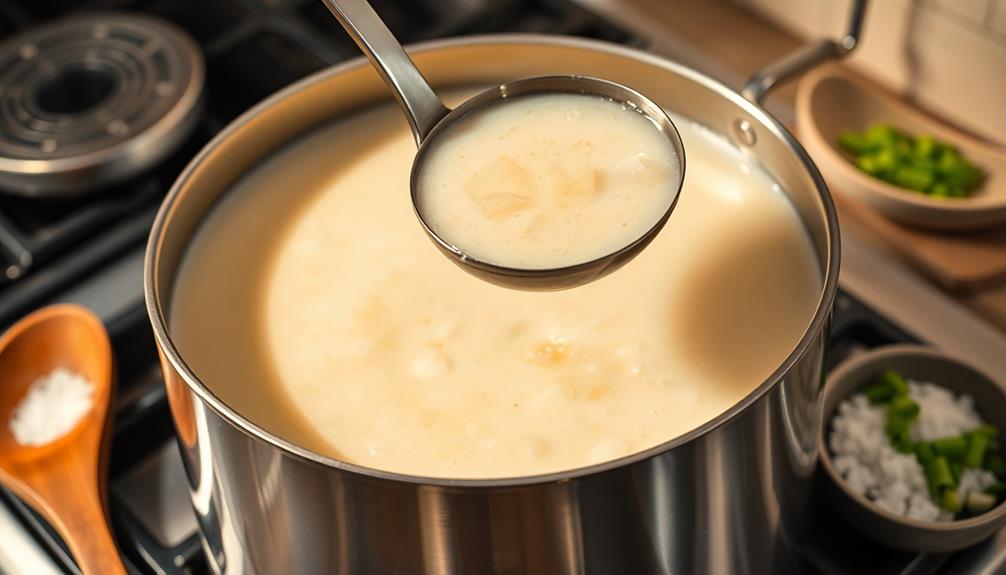
As you watch your broth simmer and develop a rich flavor, it's time to skim the fat from the surface. This step is important because it helps create a clearer, tastier soup. Grab a ladle or a spoon, and gently glide it over the top of the broth. You'll notice a shiny layer of fat floating on the surface. Don't worry; it's just the flavor doing its thing!
Carefully scoop up the fat and discard it. If you want to be extra careful, you can use a fine mesh strainer to catch any bits that don't belong. It's like fishing for the slippery stuff! You might need to do this a couple of times, especially if you've simmered your broth for a while.
As you skim, take a moment to appreciate the wonderful aroma wafting from your pot. Can you smell the deliciousness?
Just think, with each scoop, you're getting closer to a hearty bowl of seolleongtang. So, keep at it, and soon you'll have a beautiful, clear broth ready for the next step in your cooking adventure! Happy skimming!
Step 4. Add Salt to Taste
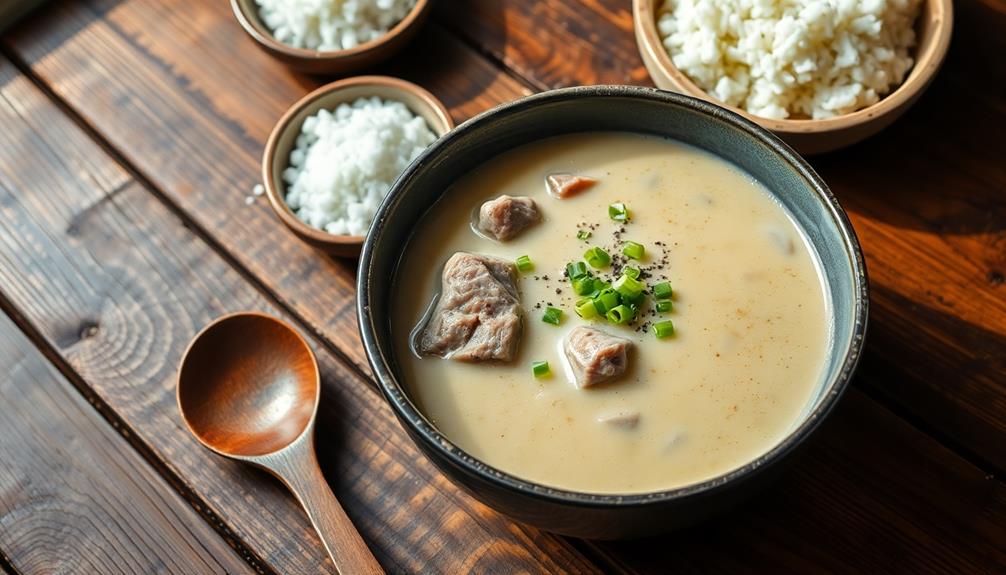
Now that you've skimmed the fat from your broth, it's time to enhance its flavor by adding salt to taste. Salt is like a magic wand that makes your Seolleongtang even more delicious! Start by sprinkling a small amount of salt into the hot broth. You don't want to overdo it, so just a little pinch at first is perfect.
Stir the broth gently as you add the salt, and let it dissolve completely. Take a moment to taste your soup. If it's not quite salty enough, add a bit more, but remember, you can always add more salt, but you can't take it out once it's in!
So, keep tasting your broth as you go along. This is your chance to make it just right for you! Maybe you like it a little saltier, or maybe you prefer a milder flavor. It's all about what makes your taste buds happy!
Once you're satisfied with the saltiness, your broth is almost ready! The soup's rich and comforting flavors are coming together beautifully, and you're one step closer to enjoying your warm bowl of Seolleongtang.
Step 5. Strain Broth Thoroughly

How can you ensure your Seolleongtang is perfectly clear and free of any impurities? The secret lies in straining the broth thoroughly!
After you've cooked your ox bones for several hours, it's time to make that delicious soup sparkle like a clear winter lake. Grab a fine-mesh strainer or a cheesecloth, and place it over a large bowl or pot.
Next, carefully pour your simmering broth through the strainer. This step captures all those pesky bits and pieces you don't want floating around in your soup. You might see some foam and fat, but don't worry; that's totally normal! Just let the broth flow slowly, and don't rush it.
Once you've strained all the liquid, take a moment to admire how clear and beautiful it looks. If you want to be extra sure it's free of any impurities, you can strain it a second time!
This extra step might take a few more minutes, but it'll be worth it. Now, your Seolleongtang is ready for the next stage, where it can soak up some lovely flavors. Get ready to enjoy a hearty, comforting bowl of goodness!
Final Thoughts
When you savor a bowl of seolleongtang, you're not just enjoying a comforting meal; you're experiencing a rich tradition steeped in history and culture.
This delicious ox bone soup has been warming hearts and bellies for generations, making it a beloved dish in Korean cuisine. You can almost picture families gathering around the table, sharing stories and laughter, all while slurping up this tasty broth.
Making seolleongtang isn't just about cooking; it's about creating memories.
The long simmering time allows the flavors to blend beautifully, resulting in a creamy, milky broth that's simply irresistible. Plus, you can customize each bowl with your favorite toppings like green onions and pepper, making it your own!
Frequently Asked Questions
What Are the Health Benefits of Seolleongtang?
You'll find that certain traditional soups offer numerous health benefits. They can boost immunity, provide essential nutrients, support digestion, and promote hydration, making them a comforting choice for overall wellness and nourishment in your diet.
Can Seolleongtang Be Frozen for Later Use?
Yes, you can freeze it for later use! Just make sure it cools completely before transferring to airtight containers. When you're ready to enjoy, thaw it in the fridge and reheat gently.
What Side Dishes Pair Well With Seolleongtang?
When enjoying a flavorful soup, you'll want side dishes that complement it. Try pickled vegetables, kimchi, or steamed rice. These additions enhance the soup's richness and provide a balanced, satisfying meal experience.
How Many Calories Are in a Bowl of Seolleongtang?
A bowl of this hearty soup typically contains around 500 calories, depending on the ingredients and portion size. If you're tracking your intake, it's good to check specific recipes or variations for accuracy.
Is Seolleongtang Suitable for Vegetarians or Vegans?
No, it isn't suitable for vegetarians or vegans. This dish contains animal bones and meat, making it incompatible with those diets. If you're looking for plant-based options, consider exploring other soups or broths instead.
